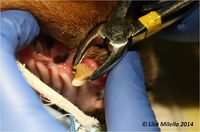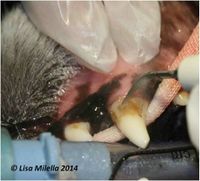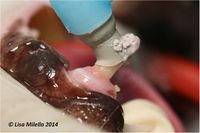Scaling and Polishing - Small Animal
Introduction
Professional periodontal therapy is performed under general anaesthesia and includes supra-and subgingival scaling, root planing and tooth crown polishing. The aim of treatment differs when the patient has gingivitis only or if there is also periodontitis. Professional periodontal treatment is carried out to deal with plaque retentive surfaces and reduce areas of plaque stagnation, ensuring the mouth is then in the best condition to enable the client to provide ongoing plaque control.
Supragingival scaling is the removal of plaque and calculus above the gingival margin. It can be performed using hand instruments alone or a combination of hand instruments and powered scalers.
Subgingival scaling is the removal of plaque, calculus and other debris from the tooth surface below the gingival margin, i.e. within the gingival sulcus or periodontal pocket. Using an explorer probe, the presence of subgingival deposits should be felt for and these should only be removed if identified.
Root planing is the removal of the superficial layer of toxin-laden cementum from the root surfaces. Root planing produces a smooth root surface which is less likely to accumulate plaque and more likely to permit epithelial reattachment.
Process
Step 1:
Prior to scaling and polishing the mouth needs to be examined, as scaling may artificially increase certain assessments; for example gingivitis.
Step 2:
Rinse the mouth with a chlorhexidine mouthwash. This reduces the bacterial aerosol created by ultrasonic scaling.
Step 3:
Remove any large pieces of calculus using extraction forceps (for example a pattern called 76N, which has small narrow beaks), without contacting or damaging the gingiva.
Step 4:
An ultrasonic scaler with a sickle shaped tip is recommended to scale the teeth. Start scaling the crowns of the teeth above the gingival margin (supragingival scaling). Always use the side of the scaler tip and never the point of the tip as this will damage the tooth enamel. Make sure that the tip is water cooled. The water setting should be set so that it produces a fine mist when in motion and a fine droplet off the point. The water reduces the heat generated by the tip, but also aides in calculus removal by the process known as cavitation. The power setting of the scaler should be set according to the manufacturer’s recommendations, but ideally at the lowest possible setting to avoid excessive heat generation. Clean all the buccal surfaces of the dental arcades that are uppermost, and then all the lingual and palatal surfaces of the opposite arcades.
Step 5:
If calculus is present below the gingival margin, then use a hand curette to remove the calculus and any diseased cementum. The hand curette has a blunt rounded toe with a sharp working edge. A Gracey curette pattern 5/6 is a useful size to clean below the gingival margin. The instrument is positioned below the gum margin with the working edge against the tooth surface to be cleaned, then pulled towards the crown. The instrument is moved circumferentially around the tooth using overlapping vertical strokes. Oblique or horizontal strokes are also used, particularly in the furcation area of multi-rooted teeth. Use an explorer probe to check that all calculus has been removed or gently puff some air under the gingival margin using the air water syringe from the dental unit.
Step 6:
The teeth are then polished to remove any remaining plaque and small bits of calculus. Immense iatrogenic damage can be caused by polishing. Always use a fine grit polishing paste with a soft rubber cup. Use plenty of polishing paste to reduce friction between the rotating cup and the tooth surface. Use enough pressure to gently flare the cup against the tooth surface. The cup can gently be flared below the gingival margin to clean any subgingival plaque. The speed of rotation should be set so that the cup just slows down when it contacts the tooth surface. Too much pressure, too much friction or too high a speed rotation will result in excess heat being produced that can ultimately cause pulpitis (inflammation of the pulp – usually irreversible inflammation, leading to pulp necrosis).
Step 7:
Rinse the mouth with water followed by a chlorhexidine mouth wash. Any further treatment such as extractions can then be carried out.
| This article was written by Lisa Milella BVSc DipEVDC MRCVS. Date reviewed: 15 August 2014 |
| Endorsed by WALTHAM®, a leading authority in companion animal nutrition and wellbeing for over 50 years and the science institute for Mars Petcare. |
Error in widget FBRecommend: unable to write file /var/www/wikivet.net/extensions/Widgets/compiled_templates/wrt6622b2217e1a39_18800031 Error in widget google+: unable to write file /var/www/wikivet.net/extensions/Widgets/compiled_templates/wrt6622b22181a405_00214891 Error in widget TwitterTweet: unable to write file /var/www/wikivet.net/extensions/Widgets/compiled_templates/wrt6622b22184d4c3_71575892
|
| WikiVet® Introduction - Help WikiVet - Report a Problem |


